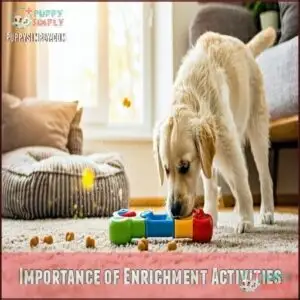This site is supported by our readers. We may earn a commission, at no cost to you, if you purchase through links.

Breeds like the Shiba Inu, Basset Hound, or Cavalier King Charles Spaniel are great choices. They’re typically calm, require less exercise, and often prefer lounging over constant activity.
The Italian Greyhound, known for its sleek elegance and easygoing nature, is another option, ideal for apartments.
While they can handle some alone time, all dogs need love, enrichment, and quality time when you’re home. A little planning goes a long way in keeping them happy—just wait until you learn about their unique traits!
Table Of Contents
- Key Takeaways
- Choosing Low Maintenance Breeds
- Top Breeds for Full-Time Workers
- Canine Needs and Separation Anxiety
- Breed-Specific Information for Workers
- Responsible Dog Ownership for Workers
- Frequently Asked Questions (FAQs)
- Which dog breed is best for a full-time worker?
- What is the best dog for working people?
- Is a dog a good fit for a full-time job?
- Can a full-time worker own a dog?
- Do dog breeds enjoy companionship?
- Are Bulldogs good work dogs?
- Can Puppies Be Left Alone?
- Are Dogs Feel Lonely?
- How Do You Know if Your Dog Likes to Be Alone?
- What Breed of Dog Can Be Left Alone During the Day?
- Conclusion
Key Takeaways
- Choose low-maintenance, independent breeds like Shiba Inus, Cavalier King Charles Spaniels, or Italian Greyhounds that handle alone time well.
- Prioritize enrichment activities like puzzle toys and short walks to keep your dog mentally and physically stimulated while you’re busy.
- Stick to consistent routines for feeding, exercise, and potty breaks, and consider options like dog walkers or sitters when needed.
- Recognize signs of separation anxiety and address them with crate training, counter-conditioning, and desensitizing to departure cues.
Choosing Low Maintenance Breeds
When you’re balancing long workdays, choosing a low-maintenance dog breed can make life easier. These breeds are independent, require minimal grooming, and adapt well to busy schedules.
Size and Energy Levels Matter
Size and energy levels truly matter when picking a dog.
Small dog breeds, like Chihuahuas or Pugs, fit perfectly into apartment living.
Low-energy dogs are ideal for busy people—they’re happy lounging instead of needing intense exercise. Low energy dog breeds are often content with less activity.
Aligning your lifestyle with your dog’s exercise requirements and energy expenditure guarantees harmony, whether you live in a cozy apartment or a spacious home.
Independent Breeds for Busy Owners
When work keeps you busy, independent dog breeds are a smart choice.
These low-maintenance companions handle alone time well, thanks to their natural self-sufficiency.
Breeds like Basenjis, Shiba Inus, and Chow Chows thrive in canine solitude, needing only the basics—a cozy spot, food, and occasional attention—to stay happy.
Their blend of independence and adaptability makes them perfect dog breeds for busy owners, and you’ll love knowing they’re content while you’re out, enjoying the fact that they are low-maintenance companions.
Low-Energy Breeds for Apartment Living
Low-energy dogs are ideal for apartment living, offering quiet companionship without demanding much.
They fit well in small spaces and adapt easily, meeting the needs of busy schedules with minimal effort.
- Basset Hounds: Relaxed, low-maintenance dogs happy lounging indoors.
- Maltese: Gentle, apartment-friendly dogs with modest exercise needs.
- French Bulldogs: Loving, quiet companions with low energy and few potty break demands.
These low-maintenance breeds are perfect for city life!
Top Breeds for Full-Time Workers
Finding the right dog as a full-time worker means choosing a breed that’s independent, low-maintenance, and adaptable.
You’ll want a companion that stays content while you’re away, yet still enjoys quality time together.
Breeds With Minimal Exercise Needs
Not every dog needs an endless backyard or a marathon runner owner.
Some breeds are perfect for small apartments and quiet lifestyles. Low-energy breeds like French Bulldogs and Shih Tzus thrive with short walks and relaxation.
Greyhounds and Basset Hounds are couch potatoes, happy lounging all day, but don’t forget obesity prevention.
Small, low-maintenance dogs, like Miniature Dachshunds and Cavalier King Charles Spaniels, suit busy people perfectly.
These low exercise needs also make them great for senior dogs or anyone looking for a laid-back, loyal companion.
Independent Breeds That Thrive Alone
Independent dog breeds are a dream for busy lifestyles, offering Breed Independence and flexibility in your routine.
Here are five excellent dogs good alone:
- Greyhounds: Couch potatoes with minimal Exercise Requirements.
- Shiba Inus: Cat-like, perfect for Alone Enrichment.
- Whippets: Gentle, calm Breed Temperament.
- Basenjis: Quiet with self-entertaining skills.
- Bullmastiffs: Big, yet surprisingly low-key and content.
These dogs thrive with independence! Owners should use positive reinforcement techniques during training.
Low-Maintenance Grooming Breeds
Finding a dog that’s easy to care for starts with understanding coat types and grooming needs.
With low maintenance dogs like the Beagle, Whippet, or French Bulldog, you’ll spend less time brushing and more time enjoying their company.
These low shedding dogs keep things tidy:
| Breed | Coat Type | Grooming Effort |
|---|---|---|
| Beagle | Short | Minimal |
| Whippet | Smooth | Low |
| French Bulldog | Fine | Easy |
For busy lifestyles, simple DIY grooming guarantees hassle-free pet care!
Canine Needs and Separation Anxiety
When you’re away at work, your dog’s emotional well-being is just as important as their physical needs.
Understanding separation anxiety and finding ways to keep your pup engaged can make all the difference in their happiness.
Recognizing Signs of Separation Anxiety
Recognizing dog anxiety is essential, especially when they’re home alone.
Understanding and addressing dog anxiety ensures your furry friend stays calm and content, even when you’re not around.
Common behavioral warning signs include:
- Destructive behaviors like chewing furniture or scratching doors.
- Excessive vocalization, such as barking or whining.
- Physical signs, like pacing/restlessness or drooling.
- Sudden appetite changes.
- Indoor accidents despite potty training.
Anxiety triggers, like your departure routine, can amplify separation anxiety, but observing your dog’s behavior helps address their discomfort effectively.
Many owners find relief with toys designed to ease anxious feelings.
Minimizing Separation Anxiety in Dogs
Keeping your dog calm when home alone is easier with the right approach.
Use these tips to tackle separation anxiety:
- Crate training creates a cozy refuge.
- Try training techniques like desensitization to ease fears.
- Provide puzzle toys for mental enrichment.
- Pair alone time with treats through counter-conditioning.
- Explore professional help for severe anxiety signs.
Addressing anxiety may involve understanding departure cue desensitization to reduce triggers.
With these methods, dog breeds for busy people can stay relaxed while you’re away.
Importance of Enrichment Activities
Preventing boredom and keeping your dog’s mind sharp is easier than you think.
Try enrichment activities like puzzle toys—they’re brain teasers for dogs.
Interactive games, such as treat-dispensing toys, encourage self-play and socialization needs.
A short walk twice daily meets training benefits and also gives both mental stimulation and exercise.
Addressing this issue early with dog separation anxiety training can make a significant difference.
Curious about ideas?
| Activity | Benefit | Frequency |
|---|---|---|
| Puzzle Toys | Mental enrichment | 3x weekly |
| Treat-Dispensing Toys | Independent engagement | Daily |
| Walks & Play Sessions | Bonding and activity | Twice daily |
Breed-Specific Information for Workers
Choosing the right breed can make balancing work and pet care much easier.
By understanding the unique traits of dogs like Cavalier King Charles Spaniels, Italian Greyhounds, and Shiba Inus, you’ll find companions that fit your busy lifestyle perfectly, which can make a significant difference in managing your time effectively with a busy lifestyle.
Cavalier King Charles Spaniel Temperament
Cavalier King Charles Spaniels are perfect for full-time workers seeking calm dog breeds with an affectionate nature.
Their balanced socialization needs and trainability factors make them easy to handle, while their exercise requirements are minimal—daily walks and indoor play are enough.
These companion dog breeds also suit small spaces beautifully, offering love without being overly demanding.
- Why They’re Great:
- Easygoing personality.
- Gentle, not territorial.
- Enjoy lounging after short walks.
- Smart and food-motivated for training.
- Responsive to positive attention.
Italian Greyhound Care and Needs
Italian Greyhounds are the definition of low-maintenance dogs, ideal for apartment-friendly living.
Their sleek coats need little grooming but make them sensitive to cold weather, so keep blankets handy. They may require specialized blanket options due to their sensitivity to cold.
They love short walks and indoor play, making them excellent low-energy dogs.
- Grooming Needs: Minimal, with occasional brushing and baths.
- Exercise Requirements: Quick walks or playtime are plenty.
- Health Concerns: Prioritize dental care and provide high-quality, breed-appropriate food to maintain their delicate frame.
Shiba Inu Training and Socialization
Shiba Inus, known for their independence, thrive with early socialization and consistent dog training. They love bonding yet demand personal space.
Use positive reinforcement to manage their stubborn Shiba temperament. Training can be challenging due to their dominant and mischievous nature.
Focus on leash training and recall challenges to guarantee safety and proper canine behavior. This is crucial for their development and your peace of mind.
| Training Focus | Key Technique | Challenge | Solution |
|---|---|---|---|
| Early Socialization | Gradual exposure | Fear of strangers | Reward calm interactions |
| Leash Training | Firm consistency | Resistance to leash | Gentle correction |
| Recall Challenges | High-value treats | Ignoring commands | Reinforce with rewards |
| Independence Training | Structured routines | Roaming behaviors | Increase mental stimulation |
The key to successful training is to be consistent and patient, as Shiba Inus can be quite stubborn at times. With the right approach, they can learn to behave well and become wonderful companions.
Responsible Dog Ownership for Workers
You’ve got a busy schedule, but owning a dog means committing to their care and well-being every day.
By planning ahead and choosing a breed that matches your lifestyle, you can guarantee your furry friend stays happy and healthy while you’re at work, which is crucial for their well-being.
Assessing Work Schedule and Dog Care
Balancing your work schedule with dog care takes some planning, but it’s totally doable.
Start by focusing on schedule compatibility. Choose a breed that fits your lifestyle and energy levels. Keep your dog’s needs met with small adjustments, like consistent mealtimes and walking breaks.
Full-time workers can use simple strategies to manage alone time. Many owners find assistance through local pet-care providers.
- Stick to routines: Regular feeding and exercise schedules build security.
- Plan walking frequency: Aim for breaks every 4-6 hours or hire a dog walker.
- Explore dog care options: Consider pet monitors or reliable sitters.
Prioritizing Dog Well-being and Happiness
Caring for your dog goes beyond picking the right breed—it’s about building a happy environment.
Building a happy environment means creating a space where your dog feels safe, loved, and mentally stimulated every day.
Even low-maintenance dogs, perfect for full-time workers, need thoughtfulness.
Regular Veterinary visits, Quality Nutrition, and Mental Stimulation activities keep tails wagging.
| Key Focus | Why It Matters | Suggestions |
|---|---|---|
| Exercise Adequacy | Burn energy, avoid boredom | Short walks or playtime |
| Socialization Needs | Build confidence, reduce stress | Introduce to pets, people |
| Dog Temperament | Guarantee lifestyle compatibility | Match energy levels |
| Affection Balance | Bond with your companion | Plan cuddle time |
| Safe Environment | Keep dogs happy and secure | Cozy bed, interactive toys |
Remember, love and attention make even "independent" dog breeds feel like part of the family!
Financial Responsibility and Lifestyle Compatibility
Dog ownership is a rewarding journey but comes with financial planning.
You’ll need a solid dog budgeting plan, accounting for food, veterinary care, grooming, insurance, and even unexpected costs like emergencies.
Breed expenses vary—some breeds, like Greyhounds or French Bulldogs, suit full-time workers with low-maintenance lifestyles.
Adjusting to these lifestyle changes guarantees your pet’s comfort without overwhelming your wallet.
Remember, adopting a dog means a lasting time commitment.
Being a responsible dog owner includes understanding these financial commitments.
Whether it’s a tiny Chihuua or loyal Labrador, your love, care, and financial responsibility create a happy, healthy home.
Frequently Asked Questions (FAQs)
Which dog breed is best for a full-time worker?
Picture a loyal friend who doesn’t mind alone time—a Greyhound, Shiba Inu, or Cavalier King Charles Spaniel fits the bill.
They’re independent, low-energy, and adaptable, making them perfect companions for a busy worker’s lifestyle, as they are low-energy.
What is the best dog for working people?
For working people, low-maintenance dogs like Greyhounds, Basset Hounds, or Cavalier King Charles Spaniels are ideal.
They’re independent, adaptable, and content with lounging, short walks, or alone time, making them perfect companions for busy schedules.
Is a dog a good fit for a full-time job?
Having a dog with a full-time job works if you plan ahead.
Choose the right breed, guarantee proper care, and create a comfortable space.
With effort, balance, and love, it’s totally manageable!
Can a full-time worker own a dog?
Absolutely, you can own a dog while working full-time.
Choose a low-energy, independent breed, set up a consistent routine, and use toys or dog walkers to keep them happy and engaged.
Do dog breeds enjoy companionship?
Some dog breeds thrive on companionship, while others are more independent.
Social breeds, like Labradors or Golden Retrievers, crave attention and bonding, whereas independent breeds, like Shiba Inus, are content with their own company for longer periods.
Are Bulldogs good work dogs?
Bulldogs are chill companions, perfect for when you’re busy.
Their laid-back vibe and low energy needs make them great for full-time workers.
Just provide some attention and exercise to keep them happy and healthy!
Can Puppies Be Left Alone?
Puppies shouldn’t be left alone for long, as they need frequent bathroom breaks, training, and socialization.
A general rule is one hour per month of age.
Plan ahead with sitters or short outings, considering the general rule to ensure their needs are met.
Are Dogs Feel Lonely?
Yes, dogs can feel lonely, especially when left alone for long periods.
They thrive on companionship and interaction.
Providing toys, soothing sounds, or hiring a dog walker helps keep them happy and entertained.
How Do You Know if Your Dog Likes to Be Alone?
When your dog’s body language says “I’ve got this,” like lounging calmly, playing with toys solo, or showing no stress signals while you’re away, it’s a clue they’re content spending time alone.
What Breed of Dog Can Be Left Alone During the Day?
Consider independent breeds like Greyhounds, Shiba Inus, or Basset Hounds.
They’re calm, low-maintenance, and content relaxing alone.
Make certain they’ve toys, comfy space, and a routine for happiness while you’re away.
Conclusion
Did you know around 23% of full-time workers own a dog?
Choosing the best dog breeds for full-time workers means focusing on low-maintenance, independent companions like the Shiba Inu, Cavalier King Charles Spaniel, or Italian Greyhound.
These breeds balance alone time with affection, making them ideal for busy owners.
Remember, your dog still needs love, enrichment, and care when you’re home.
With some planning, you can keep both your schedule and your furry friend’s well-being in harmony.
- https://pethelpful.com/dogs/dogs-for-someone-who-works
- http://www.dogreference.com/20-dogs-for-busy-people/3/
- https://www.cheatsheet.com/culture/the-best-dog-breeds-for-people-who-work-all-day.html/?a=viewall
- https://bondvet.com/b/how-to-prevent-separation-anxiety-in-dogs
- https://www.dovepress.com/canine-separation-anxiety-strategies-for-treatment-and-management-peer-reviewed-fulltext-article-VMRR















